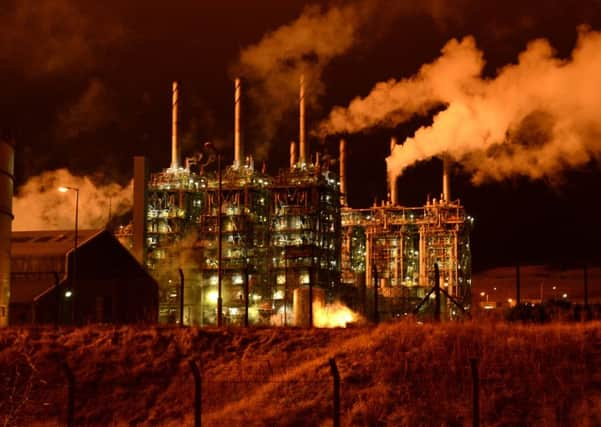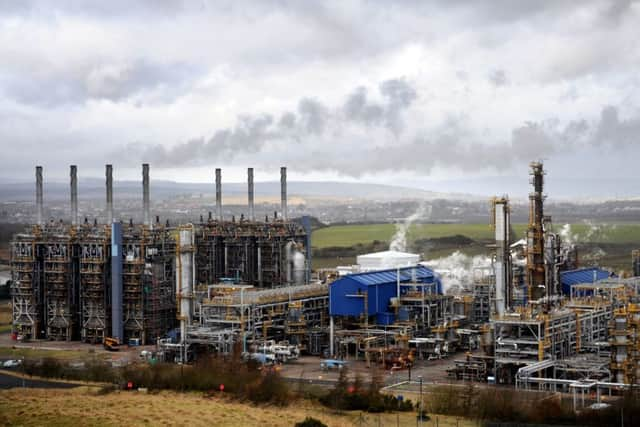Mossmorran third biggest in Scotland for green house gases


The ExxonMobil run NGL (natural gas liquids) fractionation plant on the outskirts of Cowdenbeath, hit a 14-year high for carbon dioxide emissions in 2016, pumping more than 885,580 tonnes of Co2 into the atmosphere.
The new discharge statistics also confirm there has been a rise in carbon dioxide emissions from the Mossomorran plant of more than 25 per cent in just four years since 2013
Advertisement
Hide AdAdvertisement
Hide AdThis latest pollution inventory released this month by the Scottish Environmental Protection Agency (SEPA), reveals that the controversial Fife plant at Mossmorran is now the third largest emitter of the gas which many environmentalists say is a main cause of climate change.


Combined with Shell UK Limited’s output of 193,553 tonnes of carbon dioxide from the same plant in 2016 - the 17th highest polluter in SEPA’s list - the Mossmorran facility was responsible for releasing more than 1.1 million tonnes of CO2 into the atmosphere in 2016.
Only the Petroineos plant at Grangemouth and Longannet coal powered fire station at Kincardine - which closed in March 2016 - were responsible for releasing higher quantities of CO2 for the same period.
The large rise has led to environmentalists, politicians and community groups demanding an explanation from Mossmorran’s operators over the safety and long-term efficiency of the facility and the damage it is perceived to be causing the environment.
Advertisement
Hide AdAdvertisement
Hide AdJames Glen, chairman of Mossmorran Action Group, a voluntary organisation representing several communities close to the site, told the Press the operators had still to address a number of concerns the public had raised.


“There are serious concerns about the impact to the environment and air quality as well as to the effect the plant’s emissions is having on the health and wellbeing of hundreds of people who live within the vicinity of the site.
“Also, we have long-standing concerns regarding noise and light pollution and there are still many unanswered questions about what impact the emissions and flaring are having on asthma rates.”
The problems at Mossmorran were also raised at Holyrood when Alexander Stewart, Scotland and Mid Fife MSP and Conservative spokesman for Local Government, called on First Minister Nicola Sturgeon to take affirmative action to hold ExxonMobil to account over their unannounced flaring.
Advertisement
Hide AdAdvertisement
Hide AdIn her response, the First Minister said she would be instructing the environment secretary, Roseanna Cunningham, to request a full explanation from SEPA regarding the investigation being carried out regarding the unannounced flaring at the site.
However, SEPA have recently highlighted the reduction of carbon dioxide year on year with the closure of Longannet Power Station the largest contributor to a 29 per cent decrease in carbon dioxide (CO2) emissions from Scottish industrial sites in 2016.
Martin Marsden, SEPA’s head of Environmental Quality, said: “Scotland’s transition to a low carbon economy is only possible with an ongoing reduction in greenhouse gas emissions. The SPRI figures released show that we are still moving in the right direction.
“SEPA is committed to working with all Scottish businesses to ensure that complying with their environmental responsibilities in the regulations is only the beginning.
Advertisement
Hide AdAdvertisement
Hide Ad“We will work with them to explore innovative ways they can make further improvements to reduce not only their emissions, but their overall resource consumption.”
Scotland’s 10 biggest CO2 polluters
1.65 million tonnes: Petroineos, Grangemouth
1.64 million tonnes: Scottish Power, Longannet power station, Kincardine (Closed 2016)
885,863 tonnes: ExxonMobil, Mossmorran
614,863 tonnes: Grangemouth CHP, G’mouth
601,640 tonnes: SSE Generation, Peterhead
537,029 tonnes Tarmac Cement, Dunbar
495,213 tonnes: IneosInfrastructure Grangemouth
486,809 tonnes: Ineos Chemicals, Grangemouth
438,000 tonnes: RWE Biomass plant, Markinch
370,965 tonnes: E,On Plc, Stevens Croft power station, Lockerbie